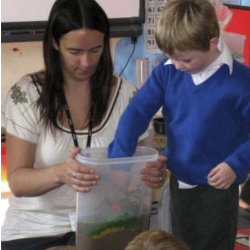Source Institutions
Source Institutions
Add to list Go to activity
Activity link broken? See if it's at the internet archive

In this activity (p.7-8 of PDF), learners examine fossil formation. Learners investigate the stages in the formation and finding of fossils: erosion, sedimentation, creatures dying and being buried, fossilization of hard remains, and scientists uncovering fossils. Use this activity to discuss how fossils, and our knowledge of the rocks in which we find them, are scientific evidence for how animals and plants looked millions of years ago and provide solid evidence for evolution.
- Under 5 minutes
- 10 to 30 minutes
- $10 - $20 per group of students
- Ages 8 - 11
- Activity, Model
- English
Quick Guide
Materials List (per group of students)
- Tall, transparent container (fully transparent is best; e.g. a large water jug) containing about 5 cm of water
- Sand (e.g. children’s sand from a garden center; best to decant the sand and let it dry out before use, because it will flow better)
- Differently colored gravels (e.g. as made for aquariums; note: the color might come off onto hands) OR Differently colored dried beans
- Some present-day shells (can buy from aquarium accessory outlets or use snail shells from a garden or shells collected from the beach)
- Models of dinosaurs small enough to fit into the transparent container
- Leaves that remain rigid after collection (fern fronds are especially appropriate for this activity)
- Model dinosaur skeletons and other dinosaur-related toys (optional)
- Toy dinosaur bones encased in plaster, which can be chipped away as archaeologists do (optional)
- Picture of eroded landscape (optional)
- Piece of sedimentary rock, even better if there is a fossil in it (optional)
Subjects
-
Earth and Space Science
-
Earth Structure
- Rocks and Minerals
-
Earth's History
- Geologic Time
- Fossils
- Dinosaurs
-
Earth Structure
-
Life Sciences
-
Diversity of Life
- Plants
- Animals
- Viruses and Bacteria
- Protists and Fungi
- Classification
-
Ecology
- Biodiversity
-
Evolution
- Evidence for Evolution
-
Diversity of Life
-
The Nature of Science
- Science as a Career
Informal Categories
- Animals
- Model Building
- Nature and Environment
Audience
To use this activity, learners need to:
- see
- see color
- touch
Learning styles supported:
- Involves hands-on or lab activities
Other
Components that are part of this resource:
This resource is part of:
Access Rights:
- Free access
By:
- Cavanagh, Dave ; Pickup, Nikki ; Cavanagh, Laura
Rights:
- All rights reserved, Professor Dave Cavanagh, Dr. Nikki Pickup and Laura Cavanagh, Institute for Animal Health,
